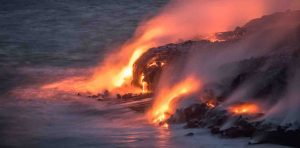
New data reveal an unprecedented depiction of a region of partially molten rock deep within the Earth, which appears to be feeding material in the form of a plume to the surface, where Iceland is located.
The finding, in combination with evidence from previous studies, suggests that these molten regions deep below, near the core-mantle boundary of the Earth, may cause basaltic ocean island chains to form along the surface. Around the Earth’s core-mantle boundary are regions called ultralow-velocity zones (ULVZs), which are characterized by liquid rock with velocities up to 30% lower than surrounding material.
However, depicting ULVZs has been particularly difficult given their extreme depths. ULVZs have been detected below the Polynesian country of Samoa and the Hawaiian islands, yet a clear depiction of their shape has eluded scientists. The proximity of these ULVZs below volcanic island chains has prompted theories suggesting that the giant reservoirs of molten rock feed the mantle plumes that create the islands on Earth’s surface.
Here, Kaiqing Yuan and Barbara Romanowicz used seismic tomography, which constructs an x-ray-like picture of the Earth’s interior using seismic waves, to probe a ULVZ below Iceland.
Based on their results, there appears to be a massive circular blob of partially molten rock, approximately 800 kilometers in diameter and 15 kilometers in height, along the core-mantle boundary, feeding the plume directly below the basaltic island.
The authors note that this ULVZ’s location, shape and large diameter, which is proportionate with the width of the plume higher up in the lower mantle, suggests a close link between the ULVZ and the rising plume above it.
These new data, in combination with the known presence of ULVZs below Samoa and Hawaii, led the authors to propose that a specific class of large ULVZs form at the roots of broad plumes that feed active hotspots.
Reference:
Kaiqing Yuan, Barbara Romanowicz. Seismic evidence for partial melting at the root of major hot spot plumes. Science, 2017; 357 (6349): 393 DOI: 10.1126/science.aan0760
Note: The above post is reprinted from materials provided by American Association for the Advancement of Science.










